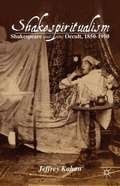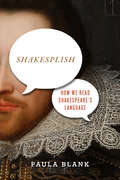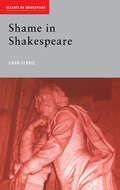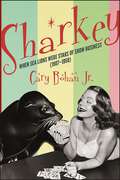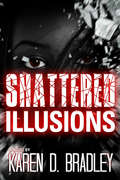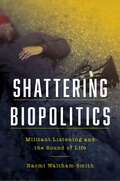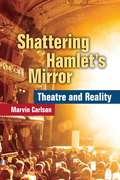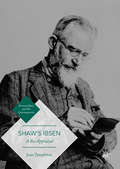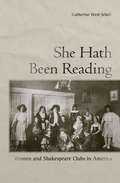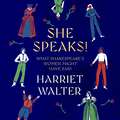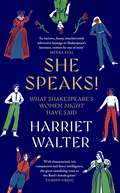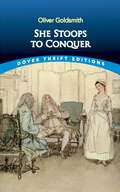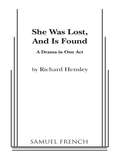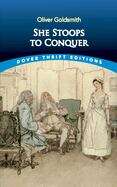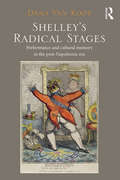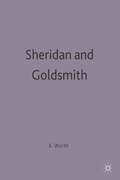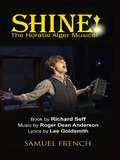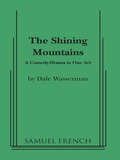- Table View
- List View
Shakespiritualism
by Jeffrey KahanThis study concerns itself with a now-forgotten religious group, Spiritualists, and how their ensuing discussions of Shakespeare's meaning, his writing practices, his possible collaborations, and the supposed purity and/or corruption of his texts anticipated, accompanied, or silhouetted similar debates in Shakespeare Studies.
Shakesplish: How We Read Shakespeare's Language (Square One: First-Order Questions in the Humanities)
by Paula BlankFor all that we love and admire Shakespeare, he is not that easy to grasp. He may have written in Elizabethan English, but when we read him, we can't help but understand his words, metaphors, and syntax in relation to our own. Until now, explaining the powers and pleasures of the Bard's language has always meant returning it to its original linguistic and rhetorical contexts. Countless excellent studies situate his unusual gift for words in relation to the resources of the English of his day. They may mention the presumptions of modern readers, but their goal is to correct and invalidate any false impressions. Shakesplish is the first book devoted to our experience as modern readers of Early Modern English. Drawing on translation theory and linguistics, Paula Blank argues that for us, Shakespeare's language is a hybrid English composed of errors in comprehension—and that such errors enable, rather than hinder, some of the pleasures we take in his language. Investigating how and why it strikes us, by turns, as beautiful, funny, sexy, or smart, she shows how, far from being the fossilized remains of an older idiom, Shakespeare's English is also our own.
Shame in Shakespeare (Accents on Shakespeare)
by Ewan FernieOne of the most intense and painful of our human passions, shame is typically seen in contemporary culture as a disability or a disease to be cured. Shakespeare's ultimately positive portrayal of the emotion challenges this view. Drawing on philosophers and theorists of shame, Shame in Shakespeare analyses the shame and humiliation suffered by the tragic hero, providing not only a new approach to Shakespeare but a committed and provocative argument for reclaiming shame.The volume provides:· an account of previous traditions of shame and of the Renaissance context· a thematic map of the rich manifestations of both masculine and feminine shame in Shakespeare· detailed readings of Hamlet, Othello, and King Lear· an analysis of the limitations of Roman shame in Antony and Cleopatra and Coriolanus· a polemical discussion of the fortunes of shame in modern literature after Shakespeare.The book presents a Shakespearean vision of shame as the way to the world outside the self. It establishes the continued vitality and relevance of Shakespeare and offers a fresh and exciting way of seeing his tragedies.
Sharkey: When Sea Lions Were Stars of Show Business (1907-1958) (Excelsior Editions)
by Gary BohanGold Winner for the 2022 Foreword INDIES Book of the Year Award in the Performing Arts & Music Category"Sharkey is the natural artist, performing his magic for nothing but love." — Wolcott Gibbs, the New YorkerSharkey tells the compelling story of an unusually gifted, trained sea lion who shared the stage with practically every important performer of the first half of the twentieth century—from Bob Hope to Ella Fitzgerald, from Broadway to Hollywood and beyond. Readers follow Sharkey and his flippered colleagues as they travel the world with stops at the Ringling Bros. and Barnum & Bailey Circus, vaudeville houses, Manhattan during the Harlem Renaissance, burlesque nightclubs, movie palaces, Radio City Music Hall, and the legendary studios of early radio, movies, and television, meeting a who's who of showbiz entertainers, sports superstars, and even a US president. Meticulously researched and lavishly illustrated, Sharkey is a quirky slice of New York and entertainment history sure to delight fans of vintage pop culture and Americana, as well as animal lovers.
Shattered Illusions
by Karen D. BradleyAt a moment’s notice, everything changes. By nightfall, terror will shake two women to the very core. No one can hear their screams over the storm that rages outside as they fight for their lives. Before the clock strikes midnight, they will lose everything they cherish most and only one will survive to tell the story. Years later, the memory of that night haunts the survivor who now goes by the name Danya Holmes. When she finds out the man who destroyed her life was released from prison, she starts to relive her worse nightmare. The truth as she knows it begins to unravel before her eyes. Every illusion she had about her past and her life will be shattered. Danya once again finds herself fighting to save her life. But will she be the one that lives to tell the story?
Shattered, Broken Restored by Grace: Mary's Story of the Amazing Power of Forgiveness
by Tracy LillerThis book will have a wide range of interested readers. It has a strong God-faith based element for Christian bookstores, as well as the Amish community. It has a story line that will appeal to all ages and is written in an easy to understand format for young readers as well. Many will relate to the traumatic auto accident while others empathize with the abusive background of the author.There will be those who have wronged others and seek forgiveness, and still others who have been wronged needing to forgive. The life lessons in this simple book far outreach what any of us can really foresee. Law enforcement officers will enjoy the realities of the job they are tasked with on a daily basis being portrayed, and courtroom employees will as well. Medical professionals will relate to the organized chaos of the trauma unit. Parents, grandparents, and children can all put themselves in the place of one losing a family member. People everywhere in every walk of life think “That could’ve been me” in many of the scenarios occurring in this book making it extremely relatable to everyone. The uplifting ending leaves its readers on an emotional high wishing to read it again and again.
Shattering Biopolitics: Militant Listening and the Sound of Life (Commonalities)
by Naomi Waltham-SmithA missed phone call. A misheard word. An indiscernible noise. All these can make the difference between life and death. Failures to listen are frequently at the root of the marginalization and exclusion of certain forms of life. Audibility decides livability. Shattering Biopolitics elaborates for the first time the intimate and complex relation between life and sound in recent European philosophy, as well as the political stakes of this entanglement.Nowhere is aurality more pivotal than in the dialogue between biopolitical theory and deconstruction about the power over and of life. Closer inspection of these debates reveals that the main points of contention coalesce around figures of sound and listening: inarticulate voices, meaningless sounds, resonant echoes, syncopated rhythms, animal cries, bells, and telephone rings.Shattering Biopolitics stages a series of “over-hearings” between Jacques Derrida and Giorgio Agamben who often mishear or completely miss hearing in trying to hear too much. Notions of power and life are further diffracted as Hélène Cixous, Catherine Malabou, and Jean-Luc Nancy join in this high-stakes game of telephone. This self-destructive character of aurality is akin to the chanciness and risk of death that makes life all the more alive for its incalculability.Punctuating the book are a series of excurses on sound-art projects that interrogate aurality’s subordination and resistance to biopower from racialized chokeholds and anti-migrant forensic voice analysis to politicized speech acts and activist practices of listening.Shattering Biopolitics advances the burgeoning field of sound studies with a new, theoretically sophisticated analysis of the political imbrications of its object of inquiry. Above all, it is sound’s capacity to shatter sovereignty, as if it were a glass made to vibrate at its natural frequency, that allows it to amplify and disseminate a power of life that refuses to be mastered.
Shattering Hamlet's Mirror: Theatre and Reality
by Marvin CarlsonTheatrical playing, Hamlet famously averred, holds a mirror up to nature. But unlike the reflections in the mirror, the theater's images are composed of real objects, most notably bodies, that have an independent existence outside the world of reflection. Throughout Western theater history there have been occasions when the reality behind the illusion was placed on display. In recent years theaters in Europe and North America have begun calling attention to the real in their work--presenting performers who did not create characters and who may not even have been actors, but who appeared on stage as themselves; texts created not by dramatic authors but drawn from real life; and real environments sometimes shared by actors and performers and containing real elements accessible to both. These practices, argues Marvin Carlson, constitute a major shift in the practical and phenomenological world of theater, and a turning away from mimesis, which has been at the heart of the theater since Aristotle. Shattering Hamlet's Mirror: Theatre and Reality examines recent and contemporary work by such groups as Rimini Protokoll, Societas Raffaelo Sanzio, the Gob Squad, Nature Theatre of Oklahoma, and Foundry Theatre, while revealing the deep antecedents of today's theater, placing it in useful historical perspective. While many may consider it a post-postmodern phenomenon, the "theater of the real," as it turns out, has very deep roots.
Shaw – “The Chucker Out”: A Biographical Exposition and Critique (Routledge Library Editions: George Bernard Shaw)
by Allan ChappelowOriginally published in 1969, in Shaw – “The Chucker Out” Allan Chappelow quotes much entirely new and previously unpublished Shaw material (the fruits of six years’ research at the British Museum and elsewhere) as the basis for his aim of assisting towards a better understanding of Shaw’s controversial character and his paradoxical attitude to life – with reference particularly to certain fallacies and misconceptions voiced by the villagers of Ayot St. Lawrence (during their otherwise favourable memoirs in Shaw the Villager) and shared by the world at large.This book threw a flood of new light on Shaw and the world in which he lived. It included new examples of Shaw’s finest and noblest pronouncements as well as of his more controversial obiter dicta, and a special feature is the way in which the development of Shaw’s ideas is shown during his exceptionally long career occupying three-quarters of a century, from his first published (and unpublished) writings in 1875 till his last in 1950.Here is Shaw at his most stimulating and entertaining (even when deliberately shocking for effect!), and many of his views – on stage censorship for example, or on making strikes illegal – were as topical and relevant in 1969 as when he propounded them.In Shaw – “The Chucker Out” the reader will find (in addition to the opening chapter which presents Shaw’s printed postcards and ‘stock letter’ replies) much new material on Shaw’s attitude to peace and war, on his ‘new alphabet’ and his succession of Wills, rare love letters and other evidence of Shaw’s attitude to sex, unique speeches on the art of the theatre and on the conduct of life, and perhaps most important of all, a most fascinating panorama of Shaw’s views on the full gamut of political themes. The subjects range through Socialism and Capitalism, Christian Economics, Democracy and Dictators, Fascism and Equality of Income, Sedition, Trade Unionism, Women in Politics, and Communism.The book’s appeal is not only to those interested in Shaw and literature, but also as a general sociological and philosophical study of the main political, social, and moral outlooks of the world at the time, in which little-known views of many of Shaw’s contemporaries and critics are given as well as his own.Most people are bewildered by the conflict in life between ideals and illusions, and not a few have been perplexed by the contrast between the unquestionable brilliance of many of Bernard Shaw’s views and the sometimes facetious statements of the clown in him. Allan Chappelow skilfully sifts the wheat from the chaff; as Vera Brittain points out, this book goes a long way towards clarification, and it seemed likely to become a standard work.
Shaw's People: Victoria to Churchill
by Stanley WeintraubShaw's opinions of, or actual relationships with notable Victorians including the Queen. Includes extensive quotes from a man whose life spanned later Victorian Britain and the first fifty years of the twentieth century.
Shawn's Fundamentals of Dance (Language of Dance)
by Ann Hutchinson GuestFirst Published in 1988. Routledge is an imprint of Taylor & Francis, an informa company.
Shaw’s Ibsen: A Re-Appraisal (Bernard Shaw and His Contemporaries)
by Joan TempletonThis book argues that Shaw was a masterful reader of Ibsen's plays both as texts and as the cornerstone of the modern theatre. Dismantling the notion that Shaw distorted Ibsen to promote his own view of the world, and establishing Shaw’s initial interest in Ibsen as the poet of Peer Gynt, it chronicles Shaw’s important role in the London Ibsen campaign and exposes the falsity of the tradition that Shaw branded Ibsen as a socialist. Further, this study shows that Shaw’s famous but maligned The Quintessence of Ibsenism reflects Ibsen’s own anti-idealist notion of his work and argues that Shaw’s readings of Ibsen’s plays are pioneering analyses that anticipate later criticism. It offers new readings of Shaw’s “Ibsenist” plays as well as a comprehensive account of Ibsen’s importance for Shaw’s dramatic criticism, from his early journalism to Our Theatres of the Nineties, both as a weapon against the inanities of the Victorian stage and as the standard bearer for modernism.
She Hath Been Reading: Women and Shakespeare Clubs in America
by Katherine West ScheilIn the late nineteenth century hundreds of clubs formed across the United States devoted to the reading of Shakespeare. From Pasadena, California, to the seaside town of Camden, Maine; from the isolated farm town of Ottumwa, Iowa, to Mobile, Alabama, on the Gulf coast, Americans were reading Shakespeare in astonishing numbers and in surprising places. Composed mainly of women, these clubs offered the opportunity for members not only to read and study Shakespeare but also to participate in public and civic activities outside the home. In She Hath Been Reading, Katherine West Scheil uncovers this hidden layer of intellectual activity that flourished in American society well into the twentieth century.Shakespeare clubs were crucial for women's intellectual development because they provided a consistent intellectual stimulus (more so than was the case with most general women's clubs) and because women discovered a world of possibilities, both public and private, inspired by their reading of Shakespeare. Indeed, gathering to read and discuss Shakespeare often led women to actively improve their lot in life and make their society a better place. Many clubs took action on larger social issues such as women's suffrage, philanthropy, and civil rights. At the same time, these efforts served to embed Shakespeare into American culture as a marker for learning, self-improvement, civilization, and entertainment for a broad array of populations, varying in age, race, location, and social standing.Based on extensive research in the archives of the Folger Shakespeare Library and in dozens of local archives and private collections across America, She Hath Been Reading shows the important role that literature can play in the lives of ordinary people. As testament to this fact, the book includes an appendix listing more than five hundred Shakespeare clubs across America.
She Speaks!: What Shakespeare's Women Might Have Said
by Harriet WalterNew parts for thirty of Shakespeare's women, letting them speak their minds, written by famed stage and screen actress, Dame Harriet Walter DBE'Bold and original... a book that anyone who cares about Shakespeare will want to own, and share' JAMES SHAPIRO'With her gravitas, empathy, intellect and absolute belly laugh wit, the unheard voices soar. A real celebration of her life and art' PHYLLIDA LLOYD'Harriet Walter's years of inhabiting and imbibing so many of those great roles gives her a special licence to speak for them. But the wit of these delightful poems also belies frustration, exasperation, and like a true "Lover's Complaint", real affection' GREG DORANDame Harriet Walter, renowned for her wonderful portrayals in Succession and Killing Eve, among others, is one of Britain's most esteemed Shakespearean actors. Now, having played most of Shakespeare's female characters, audaciously, she lets them speak their minds.With new parts for thirty Shakespearean women, written in 'Shakespearean' verse and prose, Harriet Walter goes between the lines of the plays to let us hear what she imagines - sometimes playfully and sometimes searchingly - these women were really thinking.Here's what Gertrude longed to say; why Lady MacBeth felt she should be King; how Juliet's nurse bemoaned her loss; why Ariel is anxious about freedom and what Cleopatra's handmaidens really thought of her. Ophelia surprises us, Olivia surprises herself and Miranda glimpses the future; these pieces are alongside other brilliant insights, from the servants to the sovereigns.Harriet Walter says 'Shakespeare's mind and words have been the backbone of our culture and they have seeped into my bloodstream over the decades that I have been privileged to speak them. As Ben Jonson said, he is a man for all times, but he is also a man of his time and there's the rub. Though his empathy for his female creations is miraculous, his plays mirror the hierarchy and patriarchy of his day with the result that women are seldom centre stage, have far fewer lines, and their function in the plot is always and solely in relation to a man. But not in these pages...'
She Speaks!: What Shakespeare's Women Might Have Said
by Harriet WalterNew parts for thirty of Shakespeare's women, letting them speak their minds, written by famed stage and screen actress, Dame Harriet Walter DBE'Bold and original... a book that anyone who cares about Shakespeare will want to own, and share' JAMES SHAPIRO'With her gravitas, empathy, intellect and absolute belly laugh wit, the unheard voices soar. A real celebration of her life and art' PHYLLIDA LLOYD'Harriet Walter's years of inhabiting and imbibing so many of those great roles gives her a special licence to speak for them. But the wit of these delightful poems also belies frustration, exasperation, and like a true "Lover's Complaint", real affection' GREG DORANDame Harriet Walter, renowned for her wonderful portrayals in Succession and Killing Eve, among others, is one of Britain's most esteemed Shakespearean actors. Now, having played most of Shakespeare's female characters, audaciously, she lets them speak their minds.With new parts for thirty Shakespearean women, written in 'Shakespearean' verse and prose, Harriet Walter goes between the lines of the plays to let us hear what she imagines - sometimes playfully and sometimes searchingly - these women were really thinking.Here's what Gertrude longed to say; why Lady MacBeth felt she should be King; how Juliet's nurse bemoaned her loss; why Ariel is anxious about freedom and what Cleopatra's handmaidens really thought of her. Ophelia surprises us, Olivia surprises herself and Miranda glimpses the future; these pieces are alongside other brilliant insights, from the servants to the sovereigns.Harriet Walter says 'Shakespeare's mind and words have been the backbone of our culture and they have seeped into my bloodstream over the decades that I have been privileged to speak them. As Ben Jonson said, he is a man for all times, but he is also a man of his time and there's the rub. Though his empathy for his female creations is miraculous, his plays mirror the hierarchy and patriarchy of his day with the result that women are seldom centre stage, have far fewer lines, and their function in the plot is always and solely in relation to a man. But not in these pages...'
She Speaks!: What Shakespeare's Women Might Have Said
by Harriet WalterNew parts for thirty of Shakespeare's women, letting them speak their minds, written by famed stage and screen actress, Dame Harriet Walter DBE'Bold and original... a book that anyone who cares about Shakespeare will want to own, and share' JAMES SHAPIRO'With her gravitas, empathy, intellect and absolute belly laugh wit, the unheard voices soar. A real celebration of her life and art' PHYLLIDA LLOYD'Harriet Walter's years of inhabiting and imbibing so many of those great roles gives her a special licence to speak for them. But the wit of these delightful poems also belies frustration, exasperation, and like a true "Lover's Complaint", real affection' GREG DORANDame Harriet Walter, renowned for her wonderful portrayals in Succession and Killing Eve, among others, is one of Britain's most esteemed Shakespearean actors. Now, having played most of Shakespeare's female characters, audaciously, she lets them speak their minds.With new parts for thirty Shakespearean women, written in 'Shakespearean' verse and prose, Harriet Walter goes between the lines of the plays to let us hear what she imagines - sometimes playfully and sometimes searchingly - these women were really thinking.Here's what Gertrude longed to say; why Lady MacBeth felt she should be King; how Juliet's nurse bemoaned her loss; why Ariel is anxious about freedom and what Cleopatra's handmaidens really thought of her. Ophelia surprises us, Olivia surprises herself and Miranda glimpses the future; these pieces are alongside other brilliant insights, from the servants to the sovereigns.Harriet Walter says 'Shakespeare's mind and words have been the backbone of our culture and they have seeped into my bloodstream over the decades that I have been privileged to speak them. As Ben Jonson said, he is a man for all times, but he is also a man of his time and there's the rub. Though his empathy for his female creations is miraculous, his plays mirror the hierarchy and patriarchy of his day with the result that women are seldom centre stage, have far fewer lines, and their function in the plot is always and solely in relation to a man. But not in these pages...'
She Stoops to Conquer
by Oliver GoldsmithThis charming comedy has delighted audiences for over two centuries. First performed in 1773, it concerns Kate Hardcastle, a young lady who poses as a serving girl to win the heart of a young gentleman too shy to court ladies of his own class. A number of delightful deceits and hilarious turns of plot must be played out before the mating strategies of both Kate Hardcastle and her friend Constance Neville conclude happily. Along the way, there is an abundance of merry mix-ups, racy dialogue and sly satire of the sentimental comedies of Goldsmith's day.The extraordinary humor and humanity with which Goldsmith invested this play have made it one of the most read, performed, and studied of all English comedies. It is now available in this inexpensive Dover edition, based on the text of the fourth edition, published in the year of the play's first staging.
She Was Lost, and Is Found
by Richard HensleyDrama \ Richard Hensley \ 1 m, 2 f \ Int. \ Ellen and Dan Clark anxiously await the return of their daughter, a teenage runaway. They search through their past attempting to explain her behavior but find no simple answers. Their anxiety increases when their older daughter, a model of obedience and achievement, reacts irritably toward her sisters expected return. All three face realities about themselves and their relationship with each other, and resolve to make new efforts to reconcile their family.
She stoops to conquer
by Oliver GoldsmithOliver Goldsmith's comedy She Stoops to Conquer was originally produced in London in 1773. A young lady, Kate Hardcastle, poses as a serving girl to win the heart of Charles Marlow, a young gentleman too shy to court ladies of his own class. Many deceits and turns of plot must be played out before the play concludes happily.
Shelley's Radical Stages: Performance and Cultural Memory in the Post-Napoleonic Era
by Dana Van KooyDana Van Kooy draws critical attention to Percy Bysshe Shelley as a dramatist and argues that his dramas represent a critical paradigm of romanticism in which history is 'staged'. Reading Shelley's dramas as a series of radical stages - historical reenactments and theatrical reproductions - Van Kooy highlights the cultural significance of the drama and the theatre in shaping and contesting constructions of both the sovereign nation and the global empire in the post-Napoleonic era. This book is about the power of performance to challenge and reformulate cultural memories that were locked in historical narratives and in Britain's theatrical repertoire. It examines each of Shelley's dramas as a specific radical stage that reformulates the familiar cultural performances of war, revolution, slavery and domestic tyranny. Shelley's plays invite audiences to step away from these horrors and to imagine their lives as something other than a tragedy or a melodrama where characters are entrapped in cycles of violence or struck blind or silent by fear. Although Shelley's dramas are few in number they engage a larger cultural project of aesthetic and political reform that constituted a groundswell of activism that took place during the Romantic period.
Sheridan And Goldsmith (English Dramatists)
by Katharine WorthEach generation needs to be introduced to the culture and great works of the past and to reinterpret them in its own ways. This series re-examines the important English dramatists of earlier centuries in the light of new information, ew interests and new attitudes. The books will be relevant to those interested in literatire, theatre and cultural history, and to threatre-goers and general readers who want an up-to-date view of these dramatists and their plays, with the emphasis on performance and relevant culture history. This book explores the reasons for the deep and lasting appeal of Sheridan's and Goldsmith's comedies, showing how they operate at the profound imaginative level and draw on their author's experience as Irish wits in an English scene. Their subtle dramatic techniques are examined in relation to physical features of the eighteenth-century stage. A chapter on sentimental comedy relates to plays such as Hugh Kelly's False Delicacy to the balance of irony and sentiment in Goldsmith's The Good Natur'd Man and Sheridan's A Trip to Scarborough. The continuing freshness of the comedy of mistakes, masks and Harlequin-like role playing which the two playwrights draw from the operatic and theatrical conventions of their day is illustrated from modern productions. These have helped to illuminate the psychological truth and social awareness underlying the sparkling surfaces of Sheridan's and Goldsmith's classic comedies.
Shifting Corporealities in Contemporary Performance: Danger, Im/mobility And Politics (Avant-gardes In Performance)
by Marina Gržinić Aneta StojnićThis book investigates how contemporary artistic practices engage with the body and its intersection with political, technological, and ethical issues. Departing from the relationship between corporeality and performing arts (such as theater, dance, and performance), it turns to a pluriversal understanding of embodiment that resides in the extra violent conditions of contemporary global necro-capitalism in order to conduct a thorough analysis that goes beyond arts and culture. It brings together theoretical academic texts by established and emerging scholars alike, exposing perspectives form different fields (philosophy, cultural studies, performance studies, theater studies, and dance studies) as well as from different geopolitical contexts. Through a series of thematic clusters, the study explores the reactivation of the body as a site of a new meaning-making politics.
Shine!: The Horatio Alger Musical
by Richard SeffCharacters: 13 male, 6 female. . Various sets. Winner! 2010 New York Musical Theatre Festival Award for ExcellenceWinner! National Music Theatre Network Award!. This charming rags to riches romp with a melodic score follows Ragged Dick, Horatio Alger's first best selling hero, from penniless bootblack to budding Wall Street entrepreneur. His adventures bring him face to face with scheming ex convicts, vicious comic villians, kind benefactors and a world of colorful street characters. Set in the New York Centennial summer of 1876, this full of hopes and dreams musical is perfect for the whole family. "A charming, feel-good musical. The work's tremendous heart and unabashed celebration of Alger's popular stories are in ample evidence in this appealing musical about the rise from rags to riches." - Meredith Lee, Theatermania"SHINE! is one of those wonderful musicals where an audience cares deeply for the hero. Richard Seff's book and Lee Goldsmith's lyrics perfectly capture the Horatio Alger spirit ...Composer Roger Anderson's ballads are strikingly beautiful. As for his up-tempo songs, to call each a toe-tapper would only be 10% accurate ..." - Peter Filichia, The Star-Ledger"Awfully close to the sort of musical that made the form nationally beloved in the Rodgers and Hammerstein era." - Marc Miller, Backstage"Highly tuneful...A friendly show of considerable good humor." - Playbill
Shining Mountains
by Dale WassermanComedy Drama / 8m, 1f, 1 boy. / Comp. interior/exterior / At a deserted mountain cabin, a wandering minstrel sings a ballad that evokes events 15 years past. The three fur trappers who lived there adopted a boy, the sole survivor of a wagon train attacked by Indians. A missionary couple claim the boy, who is finally won over by the motherly woman. The trappers decided to make the trek west-- to protect them. Finally the balladeer's identity is revealed. / "Funny, touching, delightful.... An original play with knife edged characterizations." - New York Daily News.
